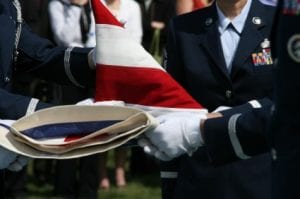Military Funeral Service Rituals
Where Bereavement Starts
 For the family of an active duty service member, military bereavement starts with a knock at the door. The news comes in person, by a military chaplain and a service member whose rank is equal to or higher than that of the one who has died. They arrive in full dress uniform, bearing the worst news possible. It’s the visit no family wants.
For the family of an active duty service member, military bereavement starts with a knock at the door. The news comes in person, by a military chaplain and a service member whose rank is equal to or higher than that of the one who has died. They arrive in full dress uniform, bearing the worst news possible. It’s the visit no family wants.
Before this solemn visit has happened, wheels are already in motion to bring the service member home. No matter what the service member’s rank was, this “dignified transfer” involves the utmost care and respect for a person whose life was given for others. The ultimate solemnity, tradition, and dignity of the military funeral are foreshadowed in the transfer process.
The Dignified Transfer
Flag-draped casket Honor guard carrying the casket Firing party firing three volleys Playing of “Taps” Ceremonial folding of the flag Presentation of the flag to the family
The service member’s remains are packed in ice inside an aluminum, flag-draped “transfer case” and transported by military cargo plane. When fallen troops return home, they enter the U.S. through Dover Air Force Base in Dover, Del. Upon arrival they are greeted and transferred with great dignity by hearse to the Air Force Mortuary Affairs Operations center at Dover, a short distance away. Those in attendance, including the carry guard, chaplain, and any family members, VIPs, or journalists, follow on foot. The remains undergo all of the necessities of burial preparation at this time, including being clothed in full dress uniform.
Arrivals at Dover were opened to the public in 2009—for the first time in 18 years—but only with the approval of the next of kin. News coverage wasn’t allowed upon the return of the 30 American troops killed in a helicopter crash in Afghanistan on Aug. 6, 2011. The remains couldn’t be identified soon enough to permit the relatives to grant permission.
Before 2007, the remains were taken only as far as the major airport nearest to the burial place and then transported by hearse. That could mean a long-distance trip for the family to meet the plane. The 2007 National Defense Appropriations Act now requires a direct flight on a military or military-contracted plane from Dover to the closest airport, even if it’s small. A military escort also is required by law. The family may request that commercial aircraft be used or that an escort not accompany the remains.
While the remains are transported in an aluminum case rather than a traditional coffin, the case is adorned with a special “honor” cover. According to the Department of Defense,
The honor cover is a reinforced cardboard cover that fits on top of the airline industry’s standard air tray for coffins. The cover is embossed with an American flag, and the Defense Department seal on both ends.
The Army designed the honor covers in cooperation with the Air Transport Association, so they are standardized throughout the airline industry. The covers are not used more than once and are treated to make them waterproof. When the remains reach their final destination, the honor cover is removed and an American flag is placed over the coffin.
Rendering Honors
By tradition, the remains travel feet-first whenever they must be moved, and there are military personnel on hand to render honors—standing at attention and saluting—at each transfer point. At times the honors may be the sole responsibility of the specially trained military escort who accompanies the remains.
For all active duty deaths, a small honor guard will provide honors for the remains when they arrive at their final destination airport. This honor guard of at least two military personnel may include the escort and one other uniformed service member.
The duties of the military escort are complete when the remains are delivered to the funeral home where interment will be held. He or she is not required to attend the service. For a personal, based-on-true-life look behind the scenes at an escort’s journey, we recommend the HBO movie Taking Chance.
What Happens to the Personal Effects
2011 Winning Photos 2011 Photo Finalists
Investigation into Mishandling of Remains
In 2011, the public was informed of an investigation into alleged mishandling of service members’ remains at the Dover military mortuary. Four families were directly affected by the investigation, which had been ongoing for 18 months before the families were informed. As a result of the investigation, three supervisors at the military mortuary were disciplined but not fired. The Air Force maintains that the incidents were isolated and that procedures have been improved following the investigation.
The Military Funeral
Tradition, honor, and dignity are the hallmarks of a military funeral. While most of the ceremonial aspects are usually performed at the grave site, an honor guard may be present and have some part in the funeral itself. The most important elements of the service are standard, whether the service member died while on active duty or was honorably discharged or retired, or whether he or she attained the rank of admiral or was newly enlisted.
Here are the elements you are likely to see at a military grave site service held at a national cemetery:
- The flag-draped casket arrives at the cemetery by hearse or horse-drawn caisson.
- A six-man honor guard carries the casket to the grave site.
- The chaplain or pastor (if applicable) reads a committal service.
- The honor guard lifts and holds the American flag taut over the casket.
- The seven-person firing party fires three volleys. A spent shell may be picked up and later tucked into the folded memorial flag.
- A bugler sounds “Taps.”
- The honor guard ceremonially folds the American flag.
- The highest ranking officer presents the folded flag to the family with a brief statement of gratitude and a salute.
Whether at a national cemetery or at a private service, each member of the honor guard has a specific role and has practiced for these occasions. They carry out every detail of the ceremony with cadence and precision. Salutes are offered in slow motion, honoring the sacrifice of a life given in service.
Private Services
A private service held in a private cemetery can still have military honors, although they will be less formal and may be performed by an honor guard from the local VA rather than from a military base. (In the absence of an honor guard, representatives from the funeral home may handle these duties; check with your funeral home counselor regarding the services available in your area.) At a minimum, the honor guard will play “Taps” and present a folded American flag to the family.
Watch an example of a Military Funeral
The Maryland National Guard Honor Guard Demonstration of Military Funeral Honors:
Contributor: Jenny Mertes
